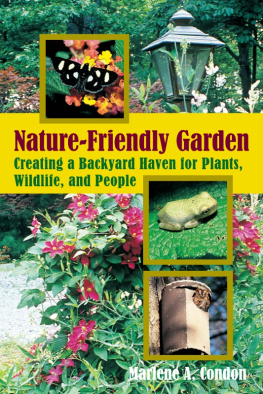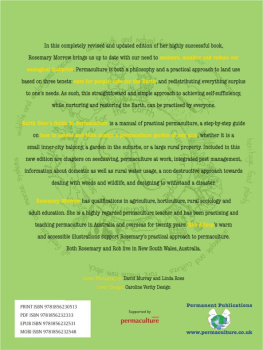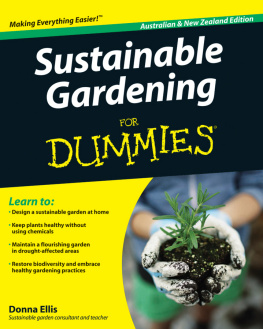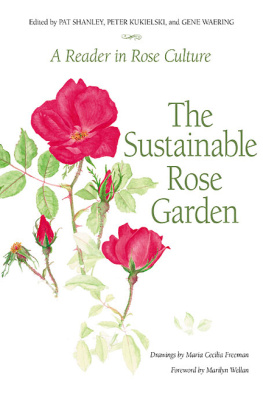GROW MORE WITH LESS
VINCENT A. SIMEONE

First Published in 2013 by Cool Springs Press, an imprint of the Quayside Publishing Group, 400 First Avenue North, Suite 400, Minneapolis, MN 55401
2013 Cool Springs Press
Text Vincent Simeone 2013
All rights reserved. With the exception of quoting brief passages for the purposes of review, no part of this publication may be reproduced without prior written permission from the publisher.
The information in this book is true and complete to the best of our knowledge. All recommendations are made without any guarantee on the part of the author or Publisher, who also disclaims any liability incurred in connection with the use of this data or specific details.
Cool Springs Press titles are also available at discounts in bulk quantity for industrial or sales-promotional use. For details write to Special Sales Manager at Cool Springs Press, 400 First Avenue North, Suite 400, Minneapolis, MN 55401 USA. To find out more about our books, visit us online at www.coolspringspress.com.
Digital edition: 978-1-61058-955-0
Softcover edition: 978-1-59186-551-3
Library of Congress Cataloging-in-Publication Data
Simeone, Vincent A.
Grow More With Less : Sustainable garden methods for great landscapes with less water, less work, less money / Vincent A. Simeone.
P. CM.
Includes Index.
ISBN 978-1-59186-551-3 (SC)
1. Sustainable Horticulture. 2. Organic Gardening. 3. Landscape Gardening. 4. Gardening--Environmental Aspects. I. Title.
SB319.95.S56 2013
635.048--DC23
2013028507
Acquisitions Editor: Billie Brownell
Design Manager: Cindy Samargia Laun
Design and Layout: Pauline Molinari
Cover Design: Karl Laun
Disclaimer
The opinions and statements contained in this book are the authors and do not represent the opinions or interests of the New York State office of Parks, Recreation and Historic Preservation.
Dedication & Acknowledgments
T his book is dedicated to my parents, Vincent and Rosemary Simeone, who instilled in me the value of hard work, loyalty, and respect. They are in my thoughts and memories every day. They both made great sacrifices in life to ensure our family was always whole. I also dedicate this book to the craft of horticulture, for which I am honored to have made my career.
From the time when I was a little boy, the wonders of nature always fascinated me. It is not at all surprising to me that forty-plus years later, I am still engaged and amazed at all of the gifts that our natural world has to offer. My appreciation for trees and my love for horticulture are partly fueled by the endless possibilities that this outdoor classroom reveals each day. My passion is equally ignited by the infinite supply of talented professionals who make me a better horticulturist each time I interact with them. The more gardens I visit and the more gardeners I meet, the more I realize how fortunate I am to be in this rewarding field. The gardening community on Long Island, New York, and all over the United States, for that matter, is indeed rich and continuously prospering. I have traveled all over the world to visit gardens and their dedicated gardeners and, without question, plants are the common denominator that pulls us together as a gardening community.
How do I even begin to thank all of the family, friends, and colleagues who have touched my life so deeply and profoundly? The list could go on forever, and Im sure I will inadvertently miss someone, so forgive my abridged version.
For the past twenty-one years I have had the pleasure of working at Planting Fields Arboretum in Oyster Bay, New York, one of many magnificent state historic parks in New York State. This horticultural jewel inspires me to teach, lecture, write, and pursue the next great garden plant to enhance our landscapes.
To so many mentors and positive influences in my life: Allan and Susan Armitage, Dave and Eileen Barnett, Michael Coe, Michael and Bonnie Dirr, Steve and Linda Finley, Gordon and Thelma Jones, and John and Connie Norbeck, just to name a few. These incredible people continue to keep me on the straight and narrow and make me a better person.
To the colleagues and family members who contributed in many ways such as motivating, editing, typing, proofreading, and sometimes suffering through endless phone calls, e-mails, and conversations about plants: Alexis Alvey, Allan Armitage, Mia Broder, Linda Copeland, Margery Daughtery, Dan Gilrein, Joanne Macrelli, Sal Pezzino, John Simeone, Ken Spencer, Michael Veracka, and Richard Weir III.
Last, but definitely not least, to my entire family who always have my back. Also, to my wife Gloria and to Chuckles and Sophie, the crazy Smooth Fox Terriers who keep me moving, and to Chauncey the cat. My animals are my salvation.
This book proved challenging and inspiring all at the same time. As I get older, I realize more and more that humans are only a part of a greater whole and that the natural world around us is a gift that we must protect and nurture. Too often we view natural resources as an entitlement that is to be used as we see fit. But it is time to realize that we are only a piece of a bigger puzzle, and we are not guaranteed the virtues of tomorrow. Sustainability is an evolving phenomenon that gives us the opportunity to ensure a better way of life for future generations. It is a responsible way of life that should be embraced as a necessary part of our culture.
TABLE OF CONTENTS
Introduction
Sustainable Gardening: Grow More with Less
T he term sustainability is a catchy phrase that has garnered a lot of attention the past few years. But unlike many catch phrases, sustainability has substance, credibility, and the potential to change life as we know it. For those who accept sustainability as a way of life, it will undoubtedly pay long-term dividends. Sustainability is a complex issue that affects every facet of our lives. But sustainability requires an investment of time and resources that will yield positive results over years to come. This commitment of time, hard work, and patience is a worthwhile effort that reduces the impact that we as human beings have on our environment. Like many worthwhile endeavors, sustainability offers us a chance to lead a responsible, healthy life and provide an example for others to learn from.
Environmental destruction is one of several reasons why sustainability has become such an important issue for so many. Human nature is to advance both intellectually and physically and that means more building, more consumption, and more resources needed. This progress comes with a price, though, usually at the cost of the environment. In the past while we built roadway systems, housing developments, shopping malls, and resorts, the long-term impact to the environment was often not considered or anticipated. But that is slowly changing and everything from large developments to residential homes has the ability to become more sustainable.
For the home gardener, the sustainability movement has taken giant steps forward over the past decade. The concept of becoming more environmentally sensitive to the natural world around us has gained momentum to the point where it now seems to be an unavoidable, irresistible force. Its no revelation that many of us have been unknowingly practicing sustainable living for many years without even realizing it. The difference is that today, sustainability isnt just an option anymore; it truly is a necessary way of life. The days of casually practicing sustainable living when it is convenient are in the past. The time has come to embrace sustainability as an everyday part of life.










